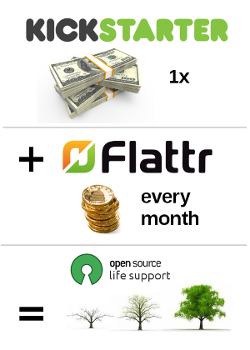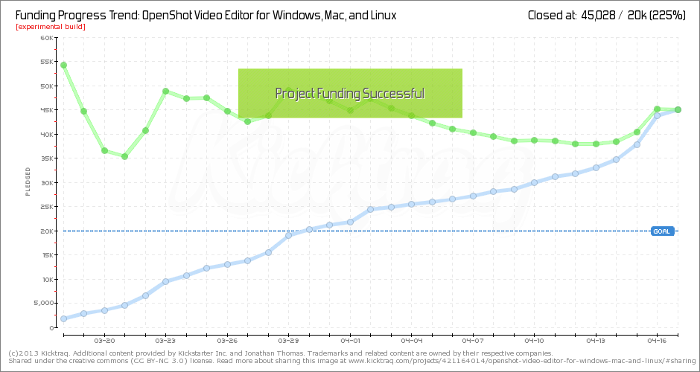Kickstarter + Flattr + Open Source = perhaps the best software support we can have
 Surely the regular reader of Habr knows what Kickstarter is and how in one year this service managed to radically change the development of computer games. By January 2013, statistics were collected for the last year - in 2012, games that successfully completed campaigns on KS received investments totaling $ 83 million. In addition to the impressive amount, the trend is also interesting: for the last one year, the gaming sector received 2 times more money than in all the previous 3 years since Kickstarter was founded. The situation is similar with other areas - but with games it looks the most advantageous.
Surely the regular reader of Habr knows what Kickstarter is and how in one year this service managed to radically change the development of computer games. By January 2013, statistics were collected for the last year - in 2012, games that successfully completed campaigns on KS received investments totaling $ 83 million. In addition to the impressive amount, the trend is also interesting: for the last one year, the gaming sector received 2 times more money than in all the previous 3 years since Kickstarter was founded. The situation is similar with other areas - but with games it looks the most advantageous.So how does this relate to free software and its development model? Yes, directly. As it happened before: a person found an interesting project, joined its development and spent evenings after work, and sometimes working time. Enthusiasm is fine, but the lack of free time is more likely to get rid of it than it will implant. Especially at the initial stage of the project, when business is mass, and free time is only 4 hours a day. Obviously, the main core of developers at the initial stage should work full-time.
And here Kickstarter comes to the rescue. Through the campaign, the necessary amount is collected, which is distributed among the developers, and is their salary for several months, during which they must build the foundation of the program, bringing it to the release state as much as possible. It is clear that the majority of open-source software has been developing for decades, and when the amount collected is exhausted, it will be necessary to maintain it on a subscription-based donate basis. And here Flattr comes to the rescue.
')
Flattr is a Swedish service designed to fill the hole between “likes” and real donations. The creators call this process “social microdonations”. How it works:
You have an account from which the amount you set up is deducted every month (say, 10 euros). If someone wrote a good comment, an article, laid out music, video - instead of the usual likes, you “flatter” what you liked. And as soon as you do this - part of the money from the account is given to this author. The money in the account is evenly distributed among all those whom you zaflettrili for the month, and at the end of the month they are sent.
If you want to support the author / service / program on an ongoing basis, then simply press the Flattr button twice, and then you subscribe to it. You can see an example of using such a button on the site of the famous GIMP editor. To see the possibility of flashing a website right away, there is an extension for Mozilla Firefox and Google Chrome .
Obviously, with a dozen subscribers, the service will pay a penny. For example, the free strategy 0 AD has collected about $ 300 since 2011. This is about 400 flatts. GIMP collected about two thousand. NoScript - more than 5000. The multiplicative factor plays a decisive role here. With the great popularity of the service, even 100 thousand people will be able to put on the flat, and this is a completely different money. The main thing is to popularize the idea (for which this post was written).
From theory to practice. Since we already have a success story that can be set as an example:
Free video editor OpenShot collected 45 thousand dollars using the Kickstarter- campaign (which even had an article on Habré), with a target of 20 thousand. The author of the project, Jonathan Thomas, who campaigned more for the sake of the experiment, did not expect such support himself, and added several stretch-heads, all of which were achieved. Especially noteworthy is the graph of the intensity of the replenishment of the budget, which stands out from the typical commercial products.
Each peak on the chart is a new publication on a large site. The third major peak is the effect of the news on Engadget.

It becomes clear that the audience is vital to support open source. Not so much in monetary terms as in the ability to convey thoughts to the broad masses of people. And they will already decide whether to support the project or not, the main thing is that they will be quantitatively several times larger and the support will increase in direct proportion.
Examples of projects available for support through Flattr:
The Document Foundation — LibreOffice Developers: flattr.com/profile/tdf
MPlayer cross-platform media player: flattr.com/thing/394611/MPlayer-the-movie-player
OpenStreetMap map service: flattr.com/profile/openstreetmap
Real Time Strategy 0 AD: flattr.com/thing/419240/0-AD-
ReactOS operating system: flattr.com/thing/505443/ReactOS
Awesome window manager: flattr.com/thing/48025/awesome-window-manager
Haiku operating system: flattr.com/thing/1338313/HAIKU-Project
Graphic editor GIMP: flattr.com/thing/707850/GIMP-is-the-GNU-Image-Manipulation-Program
Linux Mint distribution: flattr.com/thing/40006/Linux-Mint
Wikimedia Foundation: flattr.com/profile/wikimediafoundation
This is not a complete list, and if any of the projects cannot be supported, do not be lazy - write to the developers about it. Embedding Flattr support into the Donations section takes no more than five minutes. As an example, I decided to embed this button in my own post. In the case of truly voluminous and time-consuming articles on Habré, this can be a real replacement for the program of support for authors.
Source: https://habr.com/ru/post/178191/
All Articles